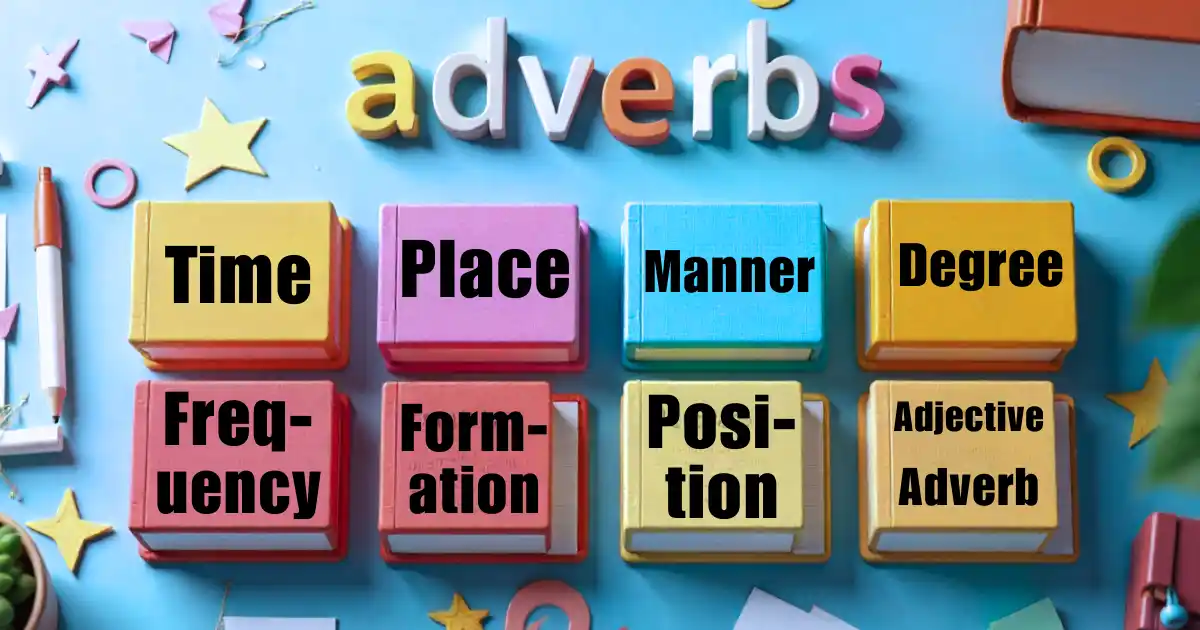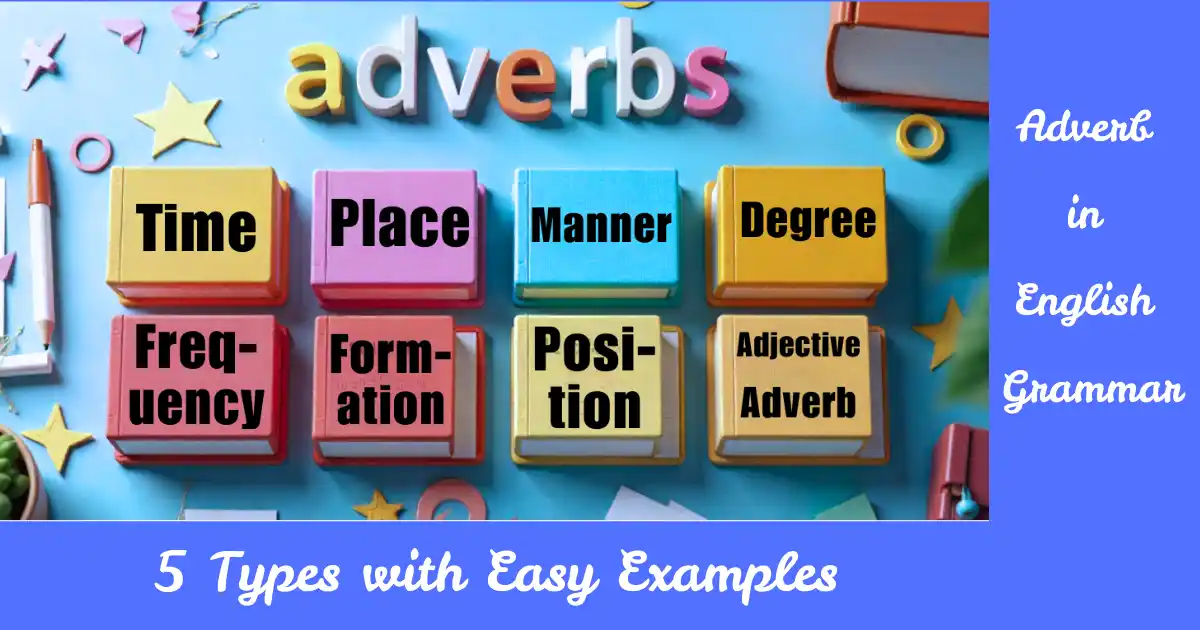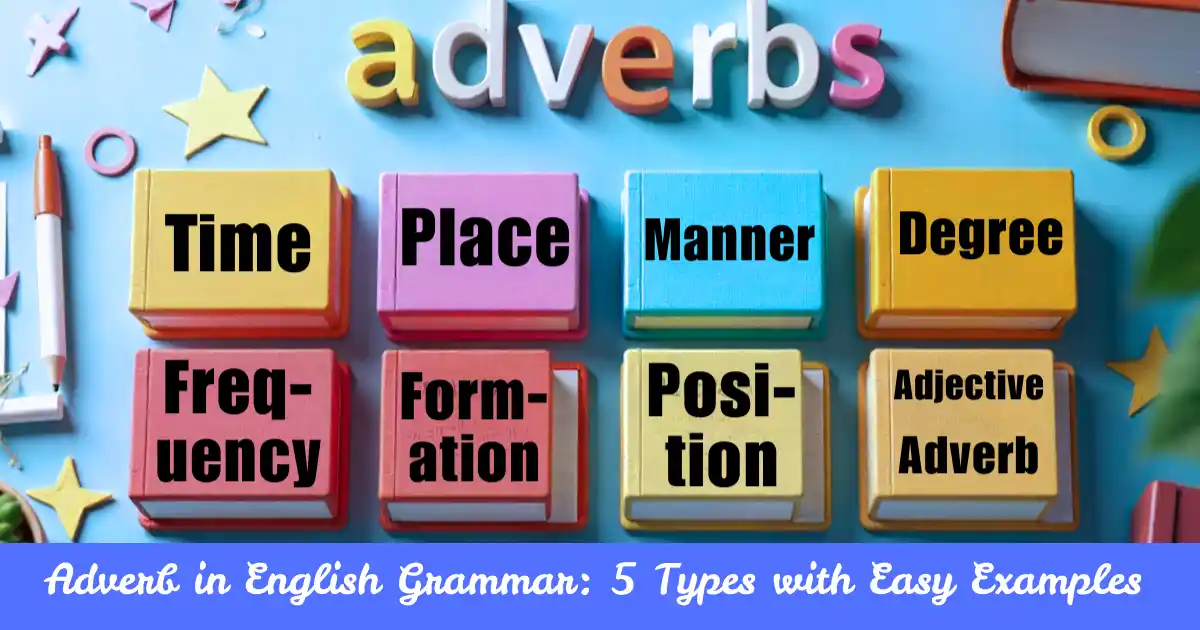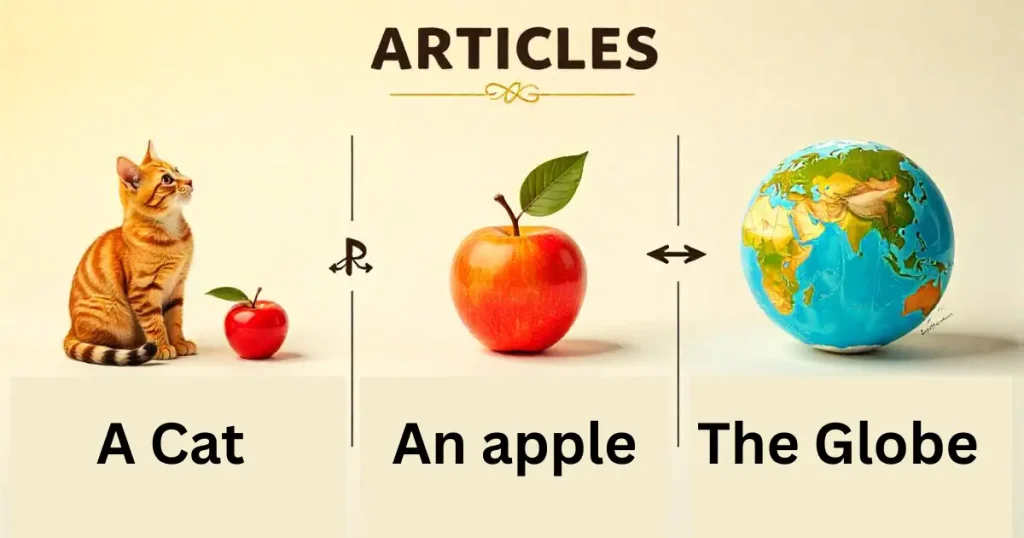Adverb হল একটি ধাতু (Verb), বিশেষণ (Adjective), অথবা অন্য একটি অ্যাডভার্বকে বর্ণনা বা পরিস্কার করার জন্য ব্যবহৃত একটি শব্দ। সাধারণত, Adverb অন্য একটি ক্রিয়ার (Action) বা ঘটনার (Event) সম্পর্কে আরও বিস্তারিত তথ্য প্রদান করে।

Verb in English Grammar: 15 Must-Know Rules
এই আর্টিকেলে, আমরা সহজ ও কার্যকর উপায়ে Adverb শেখার কিছু কৌশল এবং গুরুত্বপূর্ণ উদাহরণ শেয়ার করবো, যা আপনাকে দ্রুত শিখতে সাহায্য করবে। চলুন, দেরি না করে শেখা শুরু করা যাক!
Definition of Adverb
অ্যাডভার্ব এমন একটি শব্দ যা ক্রিয়া, বিশেষণ বা অন্য একটি অ্যাডভার্বকে নির্দিষ্ট করে। এটি সাধারণত একটি বাক্যের ক্রিয়া বা ঘটনা কিভাবে, কখন, কোথায়, কতটুকু বা কেন ঘটছে তার বিষয়ে তথ্য দেয়।
উদাহরণ:
- She runs quickly.
এখানে “quickly” শব্দটি ক্রিয়া “runs”-এর গতি বা তীব্রতা বর্ণনা করছে। - The dog barked loudly.
এখানে “loudly” শব্দটি “barked” ক্রিয়ার আওয়াজের স্তরের পরিসংখ্যান দেয়। - She is very beautiful.
এখানে “very” শব্দটি বিশেষণ “beautiful” কে আরও তীব্রতা প্রদান করছে।
He works quite hard.
এখানে “quite” শব্দটি “hard” অ্যাডভার্বকে পরিমার্জন করছে, এর মানে হল যে সে মোটামুটি কঠোর পরিশ্রম করে।
Adverbs of Time, Place, Manner, Frequency ও Degree: সহজ উদাহরণ সহ ব্যাখ্যা
অ্যাডভার্ব (Adverb) শব্দটির বিভিন্ন প্রকারভেদ রয়েছে, যেগুলি বাক্যের অন্যান্য উপাদানকে বিভিন্নভাবে বর্ণনা বা পরিস্কার করে। অ্যাডভার্বের প্রধান প্রকারভেদগুলি হলো—অবস্থান, সময়, পদ্ধতি, পরিমাণ, প্রতিক্রিয়া, এবং নিশ্চয়তা। এখানে প্রতিটি প্রকারের বিস্তারিত আলোচনা এবং উদাহরণ দেওয়া হলো:
১. Adverbs of Place
অবস্থান সংক্রান্ত অ্যাডভার্বগুলি কোন ঘটনা বা ক্রিয়া কোথায় ঘটছে তা বর্ণনা করে। এগুলি সাধারণত স্থান নির্দেশ করে।
উদাহরণ:
- Here – “She is standing here.”
- There – “The children are playing there.”
- Everywhere – “He looked everywhere for his keys.”
- Nowhere – “I have been nowhere today.”
২. Adverbs of Time
সময় সংক্রান্ত অ্যাডভার্বগুলি কোনো ঘটনা বা ক্রিয়া কখন ঘটেছে, ঘটছে বা ঘটবে তা বর্ণনা করে। এগুলি সময় বা সময়কাল নির্দেশ করে।
উদাহরণ:
- Now – “She is now at the office.”
- Today – “I have a meeting today.”
- Soon – “He will arrive soon.”
- Yesterday – “They went to the park yesterday.”
- Never – “I have never been to New York.”
৩. Adverbs of Manner
পদ্ধতি সংক্রান্ত অ্যাডভার্বগুলি কোনো ক্রিয়া বা ঘটনা কিভাবে ঘটছে বা হচ্ছে তা বর্ণনা করে। এটি ক্রিয়ার ধরন বা গতি সম্পর্কে জানায়।
উদাহরণ:
- Quickly – “She runs quickly.”
- Easily – “The task was completed easily.”
- Loudly – “He spoke loudly.”
- Carefully – “She painted the picture carefully.”
৪. Adverbs of Degree
পরিমাণ সংক্রান্ত অ্যাডভার্বগুলি কোনো ক্রিয়া, বিশেষণ বা অ্যাডভার্বের শক্তি বা পরিমাণ বর্ণনা করে। এগুলি কোনো কিছু কতটুকু বা কতটা ঘটে তা জানায়।
উদাহরণ:
- Very – “The movie was very interesting.”
- Quite – “She is quite talented.”
- Too – “It’s too hot today.”
- Almost – “I almost missed the train.”
- Enough – “He is tired enough to go to bed.”
৫. Adverbs of Frequency
প্রতিক্রিয়া বা সাদৃশ্য সংক্রান্ত অ্যাডভার্বগুলি কোনো ঘটনা বা ক্রিয়া কতবার ঘটে তা বর্ণনা করে। এটি নিয়মিততা বা ফ্রিকোয়েন্সি নির্দেশ করে।
উদাহরণ:
- Always – “She always drinks coffee in the morning.”
- Often – “He often goes for a jog.”
- Never – “I never eat fast food.”
- Rarely – “They rarely visit us.”
- Frequently – “She frequently travels for work.”
৬. Adverbs of Certainty
নিশ্চয়তা সংক্রান্ত অ্যাডভার্বগুলি কোনো ঘটনা বা ক্রিয়া সম্পর্কে কতটুকু নিশ্চিত বা অদ্বিতীয় তা বর্ণনা করে। এটি কোনো কাজের নিশ্চিততা বা সম্ভাবনা বুঝায়।
উদাহরণ:
- Certainly – “He will certainly come to the party.”
- Definitely – “I will definitely help you with your project.”
- Probably – “She will probably join us later.”
Perhaps – “I will perhaps go to the cinema tonight.”

Master 5 Sentence Transformation: Assertive to Exclamatory
Adverb Formation with Prefix & Suffix: সহজ নিয়ম ও গুরুত্বপূর্ণ উদাহরণ
Adverb গঠন করতে প্রিফিক্স (Prefix) এবং সাফিক্স (Suffix) ব্যবহার একটি গুরুত্বপূর্ণ ভাষাগত প্রক্রিয়া। প্রিফিক্স ও সাফিক্স দ্বারা শব্দের পরিবর্তন এবং নতুন শব্দ গঠন করা হয়, যা বাক্যের অন্যান্য অংশের সাথে সম্পর্কিত হয়ে আরও বিস্তারিত এবং স্পষ্ট তথ্য প্রদান করতে সহায়তা করে।
২. Prefix দিয়ে Adverb গঠন:
প্রিফিক্স এমন একটি উপসর্গ যা শব্দের প্রথমে যুক্ত হয় এবং তার অর্থ পরিবর্তন করে। যদিও প্রিফিক্স ব্যবহার করে অ্যাডভার্ব গঠন তুলনামূলকভাবে কম হয়, তবে কিছু ক্ষেত্রে এটি ব্যবহৃত হতে পারে।
সাধারণ Prefix এবং উদাহরণ:
- un-:
- বিশেষণ বা ক্রিয়া শব্দের অর্থের বিপরীত নির্দেশ করে, এবং কখনও কখনও এটি অ্যাডভার্বের গঠনেও ব্যবহৃত হয়।
- উদাহরণ:
- happy → unhappily (অ্যাডভার্ব)
- certain → uncertainly (অ্যাডভার্ব)
- in-:
- এটি “না” বা “অবিরত” অর্থে ব্যবহৃত হয় এবং কিছু বিশেষণ বা ক্রিয়াকে নেগেটিভ বা বিপরীত অর্থ দেয়।
- উদাহরণ:
- accurate → inaccurately (অ্যাডভার্ব)
- complete → incompletely (অ্যাডভার্ব)
- dis-:
- এটি বিরোধ বা বিপরীতের মানে দেয় এবং কিছু বিশেষণ বা ক্রিয়াকে বিপরীত অর্থে পরিবর্তিত করে।
- উদাহরণ:
- honest → dishonestly (অ্যাডভার্ব)
- agree → disagreeably (অ্যাডভার্ব)
১. Suffix দিয়ে Adverb গঠন
সাফিক্স হলো এমন এক ধরনের যোগ্য উপসর্গ যা কোনো শব্দের শেষে যুক্ত হয় এবং তার অর্থ বা ব্যবহার পরিবর্তন করে। অনেক Adverb সাফিক্স দিয়ে গঠিত হয়, যেগুলি সাধারণত বিশেষণ (Adjective) বা অন্যান্য অংশবিশেষ থেকে Adverb এ পরিণত হয়।
সাধারণ সাফিক্স এবং উদাহরণ:
- -ly:
- এই সাফিক্স সাধারণত বিশেষণ থেকে অ্যাডভার্ব তৈরি করতে ব্যবহৃত হয়। অধিকাংশ অ্যাডভার্ব এই সাফিক্স দ্বারা গঠিত হয়, যা ক্রিয়ার গতি, ধরন বা প্রক্রিয়া নির্দেশ করে।
- উদাহরণ:
- quick (বিশেষণ) → quickly (অ্যাডভার্ব)
- slow (বিশেষণ) → slowly (অ্যাডভার্ব)
- happy (বিশেষণ) → happily (অ্যাডভার্ব)
- careful (বিশেষণ) → carefully (অ্যাডভার্ব)
- beautiful (বিশেষণ) → beautifully (অ্যাডভার্ব)
- -ward(s):
- এই সাফিক্স স্থানের দিকে নির্দেশক অ্যাডভার্ব গঠন করতে ব্যবহৃত হয়।
- উদাহরণ:
- forward (অ্যাডভার্ব)
- backward (অ্যাডভার্ব)
- upward (অ্যাডভার্ব)
- -wise:
- এই সাফিক্স সময়, দৃষ্টিকোণ বা ধরণ নির্দেশক অ্যাডভার্ব গঠন করতে ব্যবহৃত হয়।
- উদাহরণ:
- clockwise (অ্যাডভার্ব)
- otherwise (অ্যাডভার্ব)
- lengthwise (অ্যাডভার্ব)
- -most:
- এটি পরিমাণ বা উচ্চতর স্তরের অ্যাডভার্ব গঠন করতে ব্যবহৃত হয়।
- উদাহরণ:
- almost (অ্যাডভার্ব)
- utmost (অ্যাডভার্ব)
অ্যাডভার্ব গঠন এবং কিছু গুরুত্বপূর্ণ উদাহরণ:
- সাধারণ সাফিক্স দিয়ে গঠন:
- quiet (বিশেষণ) → quietly (অ্যাডভার্ব)
- safe (বিশেষণ) → safely (অ্যাডভার্ব)
- easy (বিশেষণ) → easily (অ্যাডভার্ব)
- বিশেষণ থেকে অ্যাডভার্ব গঠন:
- bright (বিশেষণ) → brightly (অ্যাডভার্ব)
- sharp (বিশেষণ) → sharply (অ্যাডভার্ব)
- brave (বিশেষণ) → bravely (অ্যাডভার্ব)
- কিছু অস্বাভাবিক গঠন:
- bad (বিশেষণ) → badly (অ্যাডভার্ব)
- good (বিশেষণ) → well (অ্যাডভার্ব)
Tactics to find out an adverb
Adverb খুঁজে বের করার জন্য এবং বাক্যে এর অবস্থান (Position) সম্পর্কে জানতে হলে প্রথমে আমাদের বুঝতে হবে যে, অ্যাডভার্বের কাজ কী এবং এটি বাক্যে কোথায় অবস্থান করতে পারে।
অ্যাডভার্ব সাধারণত ক্রিয়া (Verb), বিশেষণ (Adjective), বা অন্য কোনো অ্যাডভার্ব (Adverb) কে বর্ণনা বা পরিস্কার করতে ব্যবহৃত হয়। তাই, একে খুঁজে বের করার জন্য কয়েকটি সাধারণ উপায় আছে:
- ক্রিয়াকে বর্ণনা করা: অ্যাডভার্ব ক্রিয়াকে ব্যাখ্যা করতে ব্যবহৃত হয়, যেমন কোনো কাজ কিভাবে, কখন, কোথায় বা কতটুকু হচ্ছে তা জানায়।
উদাহরণ:- “She sings beautifully.”
এখানে “beautifully” শব্দটি “sings” ক্রিয়ার ধরন বা গুণ বর্ণনা করছে।
- “She sings beautifully.”
- বিশেষণ বা অন্য অ্যাডভার্বকে বর্ণনা করা:
অ্যাডভার্ব কখনও বিশেষণ বা অন্য অ্যাডভার্বের পরিস্ফুটনও ঘটাতে পারে। বিশেষণ বা অ্যাডভার্বের মাত্রা, গুণ বা পরিমাণ সম্পর্কে জানায়।
উদাহরণ:- “He is very tall.” এখানে “very” বিশেষণ “tall” এর পরিমাণ বর্ণনা করছে।
- “She dances quite gracefully.” এখানে “quite” অ্যাডভার্ব “gracefully”-এর মাত্রা বর্ণনা করছে।
Adverb এর Position in Sentence: নিয়ম, কৌশল ও উদাহরণ
অ্যাডভার্ব সাধারণত বাক্যের বিভিন্ন স্থানে অবস্থান করতে পারে এবং এটি নির্ভর করে যে, অ্যাডভার্বটি কী ধরনের তথ্য প্রদান করছে (ক্রিয়া, বিশেষণ, বা অ্যাডভার্ব)। প্রধানত, তিনটি ধরনের অবস্থানে অ্যাডভার্ব থাকতে পারে:
১. বাক্যের শুরুতে:
বাক্যের শুরুতে অ্যাডভার্ব ব্যবহার করলে, সাধারণত এটি বাক্যটির টোন বা একটি বিশেষ দৃষ্টিকোণ নির্দেশ করে।
উদাহরণ:
- Suddenly, the lights went out.
(এখানে “Suddenly” শব্দটি ঘটনার আকস্মিকতার ইঙ্গিত দিচ্ছে।) - Always, she helps her parents.
(এখানে “Always” শব্দটি ক্রিয়া “helps”-এর অভ্যাসগত বা নিয়মিততার কথা বলছে।)
২. ক্রিয়ার আগে বা পরে (Position after or before the verb):
অ্যাডভার্ব সাধারণত ক্রিয়ার (Verb) কাছাকাছি অবস্থান করে এবং এটি ক্রিয়ার গতি, সময় বা জায়গা বর্ণনা করে। এটি ক্রিয়ার আগে বা পরে আসতে পারে।
- Before the verb:
- She often visits her grandmother.
(এখানে “often” শব্দটি ক্রিয়া “visits”-এর পুনরাবৃত্তি বা ফ্রিকোয়েন্সি নির্দেশ করছে।)
- She often visits her grandmother.
- After the verb:
- He works hard.
(এখানে “hard” শব্দটি ক্রিয়া “works”-এর গুণ বা শক্তি বর্ণনা করছে।)
- He works hard.
৩. বাক্যের শেষে:
অ্যাডভার্বের সবচেয়ে সাধারণ অবস্থান হলো বাক্যের শেষে। এই অবস্থানটি সাধারণত পদ্ধতি বা সময় নির্দেশক অ্যাডভার্বের জন্য উপযুক্ত।
উদাহরণ:
- She reads books carefully.
(এখানে “carefully” শব্দটি ক্রিয়া “reads”-এর পদ্ধতি বর্ণনা করছে।) - They arrived early.
(এখানে “early” শব্দটি ক্রিয়া “arrived”-এর সময় বর্ণনা করছে।)
৪. বিশেষণ বা অন্য অ্যাডভার্বের আগে:
অ্যাডভার্ব কখনও বিশেষণ বা অন্য অ্যাডভার্বের আগে অবস্থান করে তার মাত্রা বা পরিমাণ নির্ধারণ করতে পারে।
উদাহরণ:
- He is extremely talented.
(এখানে “extremely” শব্দটি বিশেষণ “talented”-এর মাত্রা বা তীব্রতা নির্দেশ করছে।) - She sings too loudly.
(এখানে “too” শব্দটি অ্যাডভার্ব “loudly”-এর মাত্রা নির্দেশ করছে।)
অ্যাডভার্বের অবস্থান সংক্ষেপে:
- Start of the sentence: সাধারণত শক্তিশালী ক্রিয়া বা ঘটনার প্রভাব সৃষ্টি করতে ব্যবহৃত হয়।
- Before the verb: কিছু অ্যাডভার্ব যেমন সময় বা ফ্রিকোয়েন্সি নির্দেশক (যেমন “often,” “never”) সাধারণত ক্রিয়ার আগে অবস্থান করে।
- After the verb: অধিকাংশ অ্যাডভার্ব সাধারণত ক্রিয়া বা বিশেষণ/অ্যাডভার্বের পরে অবস্থান করে।
- End of the sentence: বিশেষত পদ্ধতি বা স্থান নির্দেশক অ্যাডভার্ব।

Adverb বা ক্রিয়া-বিশেষণ কাকে বলে? Adverb কত প্রকার ও কি …
Difference between Adjective & Adverb: সহজভাবে বোঝার কৌশল ও উদাহরণ
Adjective কী?
Adjective হলো এমন শব্দ, যা কোনো Noun (বিশেষ্য) বা Pronoun (সর্বনাম)-কে বর্ণনা করে।
👉 এটি কোনো ব্যক্তি, বস্তু, স্থান বা ধারণার গুণ, রঙ, আকার, সংখ্যা বা বৈশিষ্ট্য প্রকাশ করে।
✨ উদাহরণ:
- She is beautiful. (Adjective → “She” কে বর্ণনা করছে)
- This is a big house. (Adjective → “house” কে বর্ণনা করছে)
- He is a honest man.
Adverb কী?
Adverb হলো এমন শব্দ, যা কোনো Verb (ক্রিয়া), Adjective বা অন্য একটি Adverb-কে বর্ণনা করে।
👉 এটি বলে দেয় কিভাবে (How), কখন (When), কোথায় (Where), কতটুকু (To what extent) কোনো কাজ হচ্ছে।
✨ উদাহরণ:
- She sings beautifully. (Adverb → “sings” ক্রিয়াকে modify করছে)
- He runs very fast. (Adverb → “fast” কে আরও modify করছে)
- The movie is extremely good. (Adverb → “good” adjective-কে modify করছে)
Adjective বনাম Adverb: প্রধান পার্থক্য
| বিষয় | Adjective | Adverb |
| সংজ্ঞা | Noun/Pronoun বর্ণনা করে | Verb, Adjective বা অন্য Adverb বর্ণনা করে |
| কী বোঝায় | গুণ, বৈশিষ্ট্য, সংখ্যা, অবস্থা | কাজের ধরন, সময়, স্থান, পরিমাণ, মাত্রা |
| প্রশ্নের উত্তর দেয় | What kind of? Which one? How many? | How? When? Where? To what extent? |
| উদাহরণ | She is smart. | She speaks smartly. |
| Sentence Position | Noun/Pronoun-এর আগে থাকে | Verb, Adjective বা Adverb-এর আগে/পরে থাকে |
| Suffix | -ful, -ous, -al, -ive | -ly, -ward, -wise, -most |
Common Confusion Examples
❌ ভুল: She sings beautiful.
✅ সঠিক: She sings beautifully. (কারণ এটি verb “sings” কে বর্ণনা করছে → Adverb)
❌ ভুল: He is a honestly man.
✅ সঠিক: He is an honest man. (কারণ এটি noun “man” কে বর্ণনা করছে → Adjective)
❌ ভুল: He works hardly.
✅ সঠিক: He works hard. (এখানে “hard” হলো Adverb, অর্থাৎ কঠোর পরিশ্রম করে)
Tips to Identify
- Adjective সর্বদা Noun/Pronoun কে modify করবে।
👉 Example: “A happy child” (Child কে বর্ণনা করছে) - Adverb Verb, Adjective বা অন্য Adverb কে modify করবে।
👉 Example: “He sings happily” (Sings কে বর্ণনা করছে) - অনেক Adverb -ly দিয়ে শেষ হয়, তবে সবসময় না।
👉 Example: fast (Adverb), well (Adverb)
Adjective ও Adverb-এর মূল পার্থক্য হলো তারা কাকে বর্ণনা করছে —
- Adjective → Noun/Pronoun কে
- Adverb → Verb, Adjective বা Adverb কে
উপসংহার:
অ্যাডভার্বের অবস্থান বাক্যের গঠন এবং তার অর্থের উপর নির্ভর করে। এটি সাধারণত ক্রিয়া, বিশেষণ, বা অন্য অ্যাডভার্বকে বর্ণনা করে এবং এর অবস্থান বাক্যের মধ্যে বিভিন্ন ধরনের তথ্য এবং মেজাজ তুলে ধরতে সাহায্য করে। অ্যাডভার্ব খুঁজে বের করার জন্য, এটি কীভাবে ক্রিয়া বা অন্যান্য উপাদানকে বর্ণনা করছে সেটি লক্ষ্য করা উচিত।
Objective & Sentence Correction Questions
Objective Questions (MCQs)
- Which of the following is an example of an adverb of manner?
- a) Quickly
- b) Always
- c) Here
- d) Yesterday
- What is the primary function of an adverb?
- a) To describe a noun
- b) To modify a verb, adjective, or another adverb
- c) To join words or phrases
- d) To replace a subject in a sentence
- Which of the following is an example of an adverb of frequency?
- a) Happily
- b) Often
- c) Carefully
- d) Slowly
- Which suffix is commonly used to form adverbs from adjectives?
- a) -ness
- b) -ly
- c) -ing
- d) -ful
- Which of these is an example of an adverb of time?
- a) Badly
- b) Now
- c) Forward
- d) Quickly
- Which sentence contains an adverb of place?
- a) She sings beautifully.
- b) They went there.
- c) He works hard.
- d) She talks loudly.
- What is the adverb in the sentence “He speaks loudly”?
- a) He
- b) Speaks
- c) Loudly
- d) None
- Which of the following adverbs modifies an adjective?
- a) Never
- b) Very
- c) Slowly
- d) Always
- In the sentence “She works very hard,” what is the role of the word “very”?
- a) Modifies a noun
- b) Modifies a verb
- c) Modifies an adjective
- d) Modifies another adverb
- Which of these is an example of an adverb of degree?
- a) Slowly
- b) Very
- c) Outside
- d) Rarely
- Which of the following adverbs describes the manner in which an action is performed?
- a) Today
- b) Often
- c) Smoothly
- d) Here
- Which adverb modifies a verb in the sentence: “He runs fast”?
- a) He
- b) Runs
- c) Fast
- d) None
- In the sentence “She arrived early,” what type of adverb is “early”?
- a) Adverb of frequency
- b) Adverb of manner
- c) Adverb of time
- d) Adverb of place
- Which of the following adverbs expresses frequency?
- a) Happily
- b) Always
- c) Carefully
- d) Loudly
- What is the suffix that can be added to “quick” to form an adverb?
- a) -ly
- b) -ness
- c) -ing
- d) -er
- Which sentence has an adverb of place?
- a) I am going there.
- b) She sings beautifully.
- c) We work together.
- d) He always arrives late.
- Which of the following adverbs of manner modifies the verb “run”?
- a) Slowly
- b) Rarely
- c) Always
- d) Here
- What is the function of an adverb of time?
- a) To describe how something happens
- b) To describe when something happens
- c) To describe where something happens
- d) To describe the degree of something
- Which of the following is NOT a common adverb of place?
- a) Here
- b) Everywhere
- c) Soon
- d) There
- What is the adverb in the sentence: “He worked very diligently”?
- a) He
- b) Worked
- c) Very
- d) Diligently
Sentence Correction Questions
- Incorrect: She sings beautiful.
Correct: - Incorrect: He works hardly ever.
Correct: - Incorrect: They arrived earlier than expected at the airport.
Correct: - Incorrect: She is quick runs.
Correct: - Incorrect: The dog barks loud.
Correct: - Incorrect: We are going there soon.
Correct: - Incorrect: He sings very good.
Correct: - Incorrect: I have never seen him so angry like this.
Correct: - Incorrect: She is always sings in the morning.
Correct: - Incorrect: The movie was very boringly.
- Correct:

